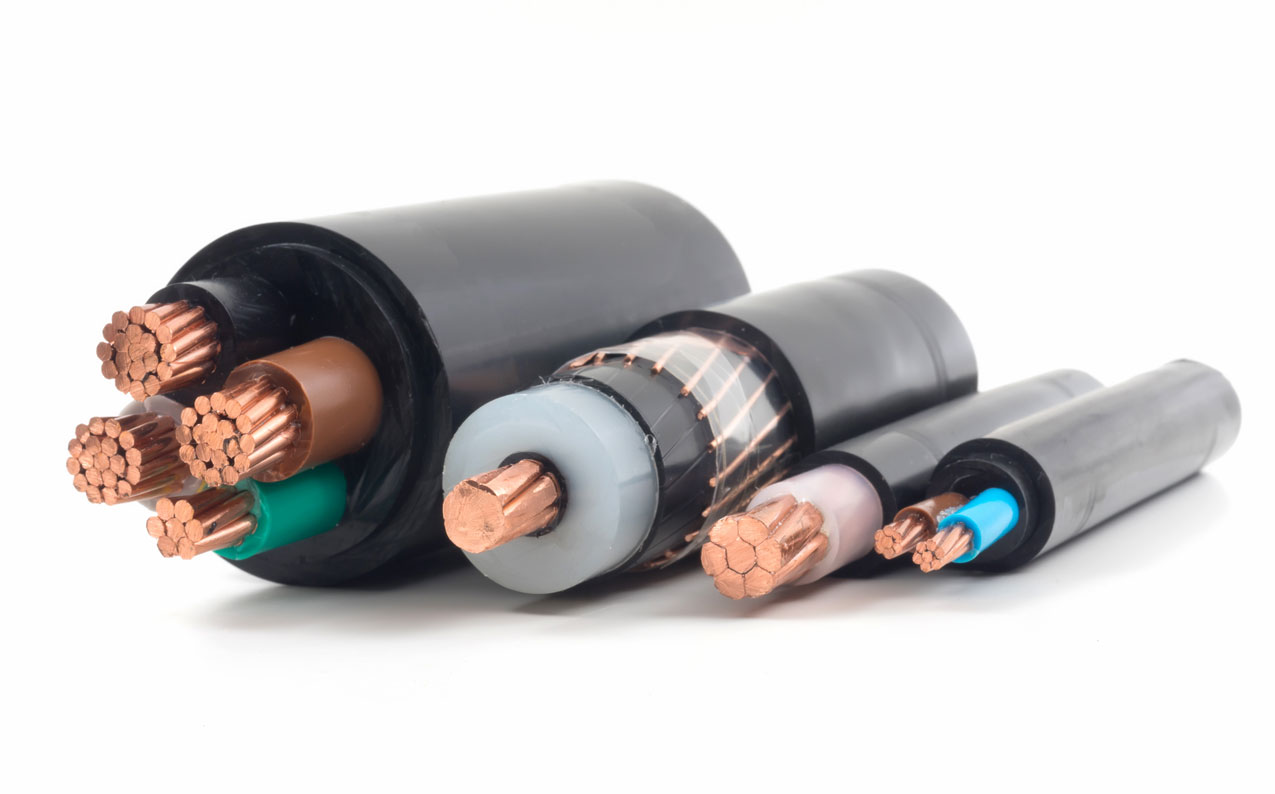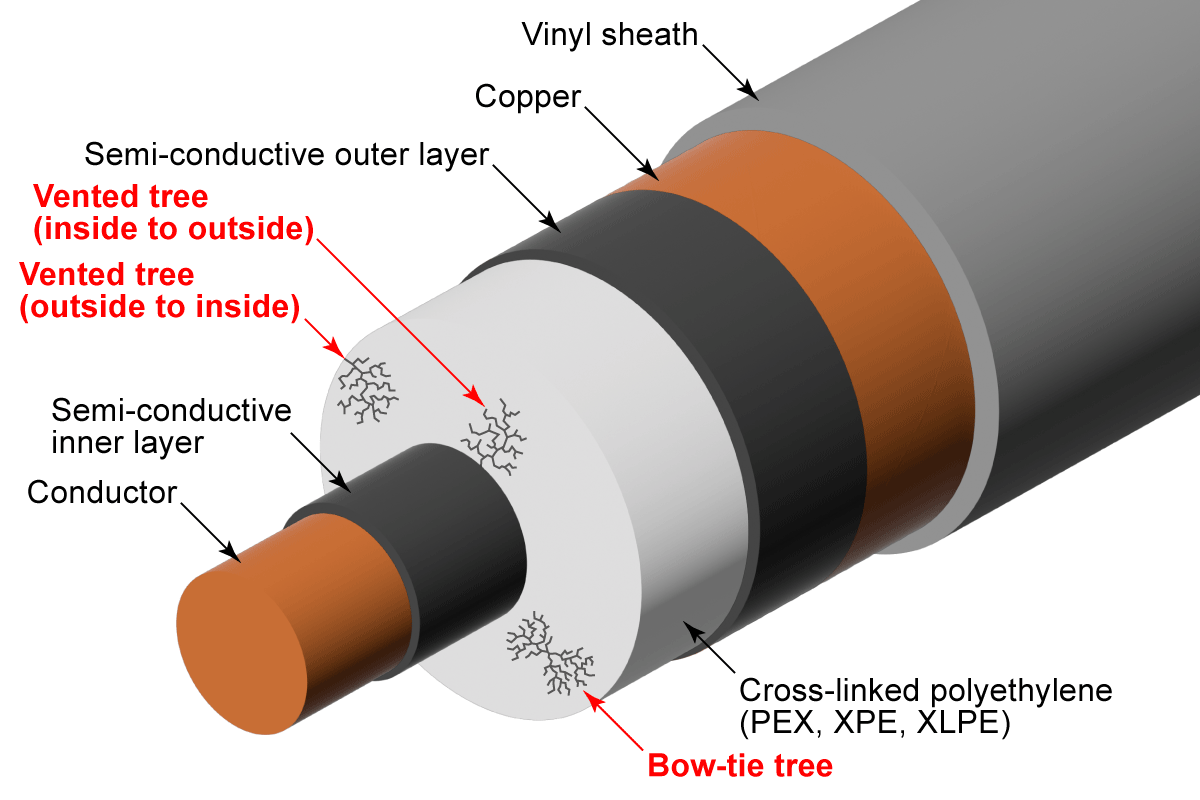Water treeing is a phenomenon in which dendritic cracks occur in the insulation of high-voltage power cables, reducing the cable's insulation performance. Water trees can lead to insulation breakdown, resulting in a major accident. In this article, we will introduce the causes and countermeasures for water treeing.

What is WATER TREEING?
Water treeing is a phenomenon in which small cracks occur in cross-linked polyethylene (CV) used for insulating high-voltage power cables (CV cables) due to the influence of water and alternating current electric fields, and these cracks develop like tree branches. It's a phenomenon. It was named "tree" because of the shape of its cracks.
There are not only water trees but also electric trees. Both of these refer to cracks that grow in a dendritic manner in an insulator, but electric trees arise from localized areas of high electric field. On the other hand, water trees are characterized by the fact that they originate from water in areas that are in contact with water.
A water tree is an aggregate of countless water droplets with a size of 0.1 to 1 [μm], so it has higher conductivity than the surrounding insulator. Therefore, when water trees occur, the insulation performance of the cable will be greatly reduced. If left unchecked, they can cause insulation breakdown accidents.
Usually, cables that cause water trees are cables that carry high voltage electricity such as 6600V. Therefore, if an insulation breakdown accident occurs, it will develop into a high-voltage ground fault. As a result, the entire facility where the cable is used may experience a power outage, or worse, a power outage involving the surrounding area.
If this happens, compensation may be sought for damages for the impact on the surrounding area. Therefore, it is necessary to check whether water trees are occurring in high-voltage power cables and to take measures to prevent water trees from occurring.

Classification of water-tree phenomena
The water-tree phenomenon can be divided into three types depending on where it occurs.
- Vented tree (inside to outside):
-
Inside vented trees first occur in the semiconducting layer inside the cable between the conductor and the insulation. The protrusions thus generated erode into the external insulation. It progresses by branching out like a tree growing out of the internal semiconducting layer.
- Vented tree (outside to inside):
-
Vented trees originating from the outer semiconducting layer in the outer semiconducting layer of the cable. From its protrusions, it erodes into the internal insulation.
- Bowtie-shaped water tree:
-
A bowtie-shaped water tree that occurs in insulation materials. It is compared to a bowtie in which cracks progress from a single point inside toward multiple directions. The cause of bow-tie trees is a small gap (void) created in the manufacturing process of cross-linked polyethylene, which is the insulating material, and from there erosion begins.
Inside and outside vented trees are caused by slight protrusions in the semiconducting layer. This occurs particularly frequently when conductive tape is used for the semiconductive layer, and is caused by the fabric that makes up the conductive tape.
On the other hand, bowtie water trees occur from air bubbles (voids) or foreign objects in the insulation. Therefore, in order to prevent bowtie-like water tree formation, it is necessary to prevent air bubbles and foreign matter from getting mixed in when molding the insulator.
When the water-tree phenomenon occurs, the insulation performance of the cable is severely degraded. Furthermore, if a cable with water treeing is left unattended, the cracks will grow and pinholes will appear in the insulation. If this happens, the conductor and the shielding layer will conduct through a pinhole, leading to a ground fault accident.
Causes of water-tree phenomenon
There are three reasons why water trees occur:
- Gaps: Gaps caused by foreign matter or air bubbles mixed in during the manufacturing process, mechanical stress, or repetitive stress.
- Moisture: Water droplets are more likely to form in the insulation layer if the cable is immersed in water.
- Electric field: Abnormal voltage generated in the grid, such as circuit switching surges and lightning surges
The water-tree phenomenon occurs when water vapor or an electric field affects the gaps that occur in the insulation of a cable or between the conductor, semiconducting layer, and insulation layers.
These gaps are caused by foreign matter and air bubbles that enter the insulation during the cable manufacturing process, and by layer separation between the semiconducting layer and the insulation. Also, during cable installation, stresses placed on the cable during construction can cause cracks in the insulation and between each layer.
When the cable is energized, partial discharge (corona discharge) occurs in these gaps, although it is not a high voltage. If a cable is used for a long time and is subjected to repeated electrical discharges, the insulation will erode.
At this time, if water infiltrates the insulation of the cross-linked polyethylene cable, foreign objects enter the polyethylene layer, or gaps or protrusions occur, the electric field will change in that area. Then, due to the synergistic effect of the discharge and the electric field, the destruction progresses and the tree grows into a shape called a tree.
In recent years, three layers, an insulating layer and inner and outer semiconductive layers, have been made using a co-extrusion method, and vented trees have become almost non-existent.
Measures for water-tree phenomenon
To prevent the water-tree phenomenon, three factors that cause water-trees must be avoided. Specifically, the following measures are effective
- Use of EE cable: Reduces the possibility of foreign matter entering the resin portion of the cable, which is the insulation.
- Do not immerse cables in water: Do not allow water droplets to form in cable gaps, and do not allow condensation to form.
- Be aware of power shutdown operations: Do not shut down circuits while current is flowing to avoid generating switching surges.
Water treeing cannot always be prevented by taking these measures. This may occur depending on the usage environment or age. Water trees must be detected and taken measures before they lead to ground faults.
Water trees can be inspected using the direct current leakage current method, which detects water trees from the voltage applied to the cable insulation and detected leakage current, or by applying a voltage of twice the commercial frequency + 1Hz, 50V to the grounding wire. There is an AC superimposition method that catches the signal flowing through the tree section.
- Caution: About water treeing problem
- Water treeing is primarily a problem in high-voltage grid cables used in the kilovolt order, with insulation materials such as polyethylene (PE) or cross-linked polyethylene (XLPE), and that are more than 10 years old. However, the occurrence of water treeing is influenced by operating and environmental conditions. If you need confirmation about the cable you are using, please contact the cable manufacturer.
Our high-voltage power supplies are used in Electric Tree experiments.
Reference (Japanese site)
- 電気工事ノウハウ大全集 - 高圧ケーブルの水トリー現象とは?原因と対策
(https://denkou-nouhau.com/mizutori-gensyo/) - 関東電気保安協会 - 高圧ケーブルの水トリー現象
(https://www.kdh.or.jp/safe/document/knowledge/hp_equipment05.html) - 東京電設サービス - 高圧ケーブル劣化診断技術
(https://www.tdsnet.co.jp/technical/high-voltage-cable-deterioration-diagnosis/)


